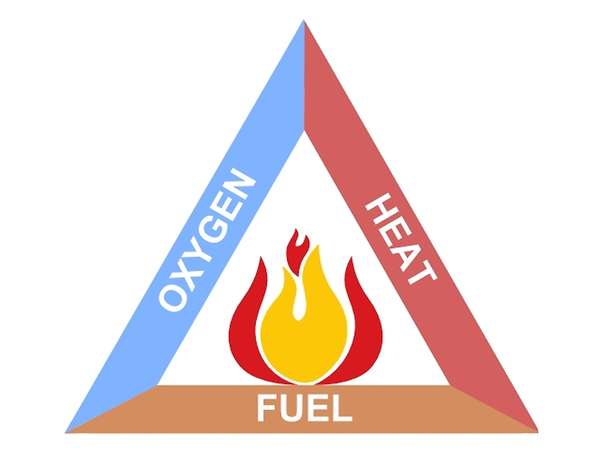Temperature, turbulence and time: 3 Ts of VOCs combustion
Let’s find the right mix for VOCs abatement
In this article we want to discover more about the phenomenon of combustion by analyzing its fundamental elements and verifying how they affect the abatement of VOCs.
In detail, we will try to answer these questions:
- What is combustion?
- What are the elements that combine to achieve complete combustion?
- How do they affect the effectiveness of abatement of VOCs?
We begin by giving an answer to the first question.
What is combustion?
Combustion is a chemical reaction in which a fuel is oxidized by a comburent (usually oxygen) creating heat and electromagnetic radiation (also light). For the latter aspect, combustion is defined as an exothermic reaction.
This phenomenon can be represented by the “fire triangle” which indicates the three elements that must be present simultaneously for the combustion:
- the fuel (solid, liquid, gaseous);
- the comburent (air containing oxygen or other substances that release oxygen);
- the trigger energy (heat, temperature).
In the field of pollution control, combustion is the reaction of oxygen with one or more compounds generally containing carbon and hydrogen and, sometimes, other atoms such as: sulfur, nitrogen or halogenated ones.

In detail, the phenomenon occurs when the initial bonds of a carbon-based chemical substance are broken and bound to oxygen, typically forming carbon dioxide and water (while, for the other atoms, the relative acid is formed). This reaction is represented by the following chemical formula: VOC + O2 → CO2 + H2O + NO2 + HCl + SO2.
The three T’s of combustion and the abatement of VOCs
When we speak of the abatement of VOCs, however, we must also consider another aspect, known as “The three T’s of combustion”. This term is used to indicate three elements that play a fundamental role in the effectiveness of abatement and are: temperature, turbulence and residence time.
Before analyzing these three factors, we should take a small step back to understand more about thermal oxidizers and their role. They are heat recovery systems that exploit the principle of thermal oxidation (at high temperature) to break down the volatile organic compounds present in the air flows. In detail, oxidative systems have a combustion chamber in which pollutants are burned and transformed into harmless substances such as carbon dioxide (CO2) and water vapor (H2O).
The aim is therefore to reduce as much as possible the VOCs guaranteeing, at the same time, thermal efficiency and management efficiency. For this reason, during the design of the thermal oxidizers, we must take into account all the variables that affect the effectiveness of abatement. It is at this point that the three T’s we talked about obtain a main role.
For complete combustion it is necessary to ensure that:
- the oxygen and the pollutant remain in the chamber for the right amount of time and at the right temperature;
- in the combustion chamber there is the right amount of oxygen appropriately mixed with the pollutants (turbulence).
Let’s analyze together these three important elements!
Time
The residence time of the pollutants inside the combustion chamber varies according to the type of VOC. In general we can say that the average time is equal to 0.5 – 1 second but, with complex hydrocarbons, it increases up to 2 or more seconds because they are more difficult to break down.

Temperature
With temperature, in this case, we mean the one present inside the combustion chamber. It is a fundamental variable in VOCs thermal oxidation because:

- at too low temperatures the bonds do not break (and therefore the compounds are not broken down);
- at temperatures that are too high, in absence of correct operating conditions, carbon monoxide (CO) would form. It is extremely toxic and therefore harmful to both people and the environment.
Like the residence time, the temperature is also influenced by the type of VOC to be treated because, depending on the structure, the bonds of the compounds can break at high or low temperatures.
Turbulence
Turbulence is the parameter to evaluate how well mixed and in motion are the molecules present inside the effluent. The degree of turbulence, between oxygen and pollutants to break down, is of primary importance. Typically, the Reynolds number is the parameter that defines turbulence. In an oxidizer it is calculated as:
Re = ((Oxidative system internal diameter) x (effluent speed) x (effluent density)) / (effluent viscosity)
To ensure complete turbulence, Reynolds number must be above 10,000.
As can be seen, the Reynolds number parameters are in some way related to each other and also a function of temperature. Great importance assumes the speed of the effluent at high temperatures that typically must be greater, where possible, at 6 m/s.
It is clear that each type of pollutant requires different design considerations because, to achieve optimal effectiveness and efficiency of abatement, it may be necessary to modify turbulence, temperature and residence time.
However, to these three parameters, we need to add a fourth: the concentration of oxygen in the effluent.
In heat recovery systems, generally, oxygen is an integral part of the effluent and it is hardly necessary to add more to ensure that the minimum excess of air is achieved. Typically, in oxidative systems, this value is adopted as at least 3% in excess respect the stoichiometric quantity. Typical values of oxygen concentration at the stack, for oxidizers, are about 15% or more, depending on application, input data and input conditions.
From the above, it is easy to understand how all these factors must be balanced to find the right mix able to break down VOCs. For this reason, the design of the thermal oxidizers must be carried out by people specialized in the sector and with the right knowledge in this field.
Our staff is able to design the best solution based on your production needs!
Do not hesitate to contact us and continue to follow our blog!